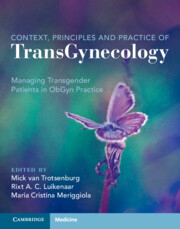Book contents
- Context, Principles, and Practice of Transgynecology
- Context, Principles, and Practice of Transgynecology
- Copyright page
- Dedication
- Contents
- Foreword
- Preface
- Contributors
- Abbreviations
- Section A Contextual Transgynecology
- Section B Practicing Transgynecology
- Section C Gynecological Surgery for Transgender Males
- Section D Sexuality and Contraception
- Chapter 21 Transition-related Sexual Health Care
- Chapter 22 Contraceptive Advice for Trans Male Persons
- Chapter 23 Sexual Abuse and Trauma-informed Care for Transgender and Gender Diverse People in Ob/Gyn Practice
- Section E Fertility and Reproduction
- Section F Impact of Gender-affirming Hormonal Therapy on Genital Organs
- Section G Screening and Prophylaxis
- Transgynecology Index
- References
Chapter 21 - Transition-related Sexual Health Care
from Section D - Sexuality and Contraception
Published online by Cambridge University Press: 22 December 2022
- Context, Principles, and Practice of Transgynecology
- Context, Principles, and Practice of Transgynecology
- Copyright page
- Dedication
- Contents
- Foreword
- Preface
- Contributors
- Abbreviations
- Section A Contextual Transgynecology
- Section B Practicing Transgynecology
- Section C Gynecological Surgery for Transgender Males
- Section D Sexuality and Contraception
- Chapter 21 Transition-related Sexual Health Care
- Chapter 22 Contraceptive Advice for Trans Male Persons
- Chapter 23 Sexual Abuse and Trauma-informed Care for Transgender and Gender Diverse People in Ob/Gyn Practice
- Section E Fertility and Reproduction
- Section F Impact of Gender-affirming Hormonal Therapy on Genital Organs
- Section G Screening and Prophylaxis
- Transgynecology Index
- References
Summary
The sexual lives of trans and gender diverse people (TGD) have historically been over-medicalized and (psycho-)pathologized. Moreover, heteronormative principles often guided transition-related care. People and/or institutions often have the unfounded assumption that everyone is cisgender and heterosexual, and that this combination is superior. This chapter on sexuality aims at informing the (medical) professional of the sexual life of TGD people, in all its diversity and complexity.
- Type
- Chapter
- Information
- Context, Principles and Practice of TransGynecologyManaging Transgender Patients in ObGyn Practice, pp. 159 - 167Publisher: Cambridge University PressPrint publication year: 2022



